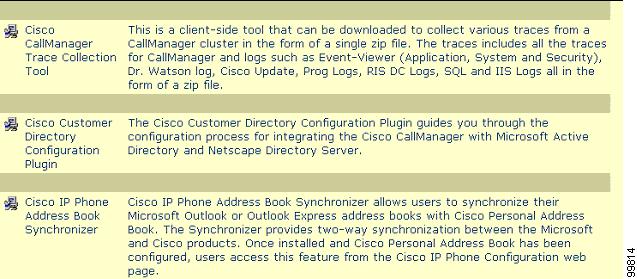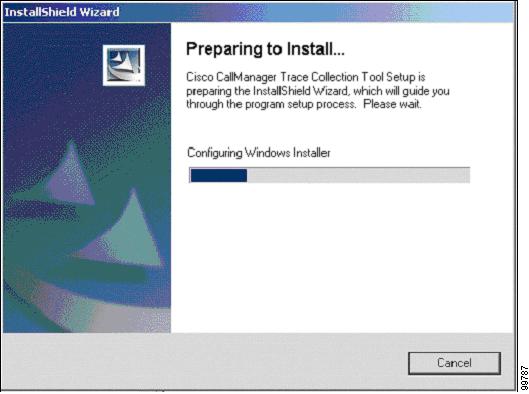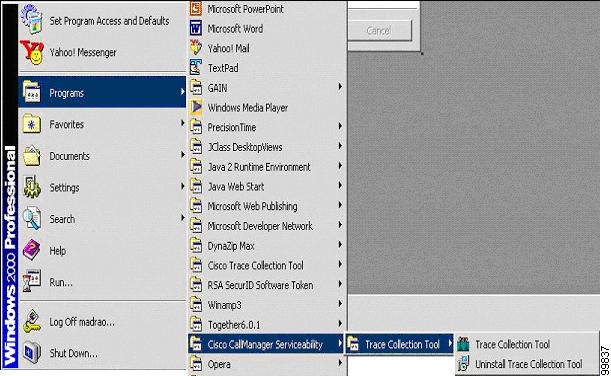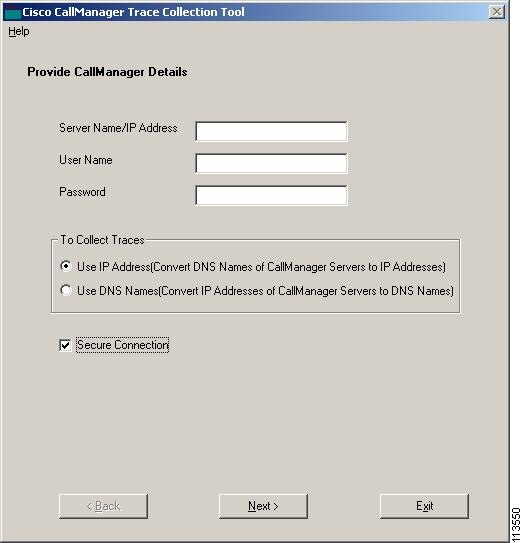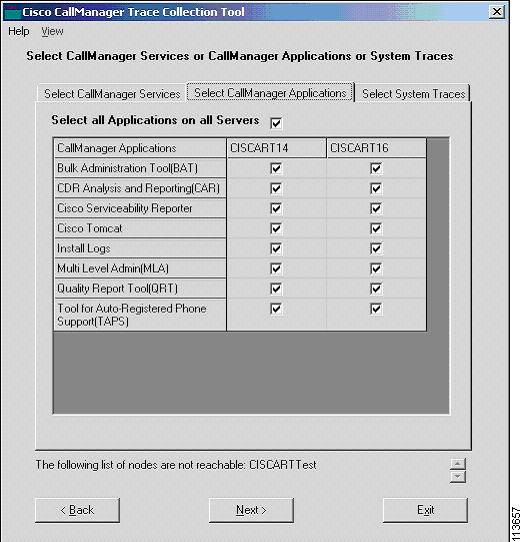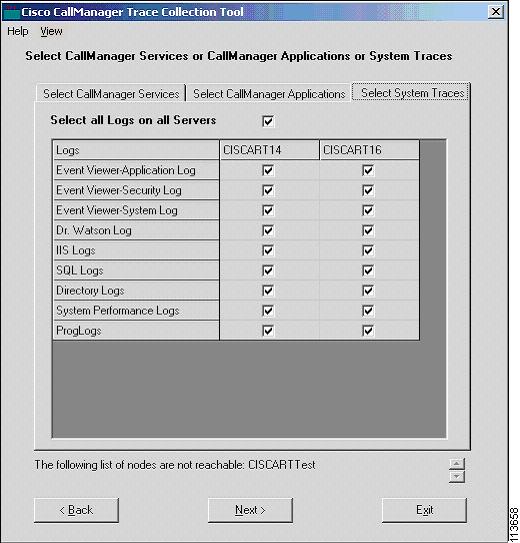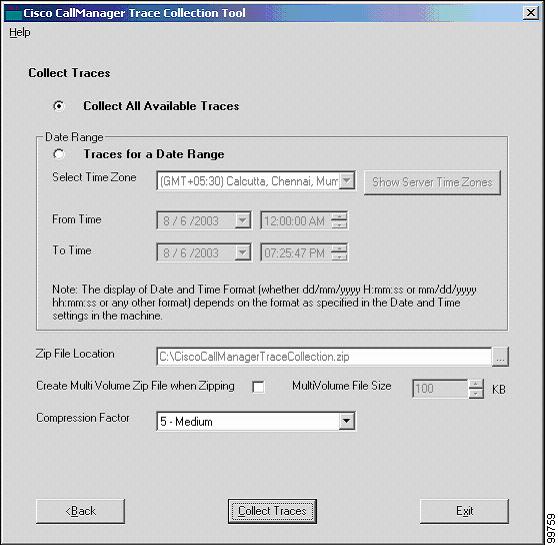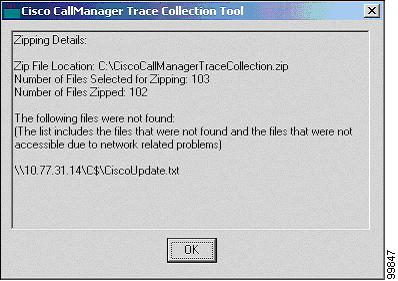

-
Cisco Unified CallManager Serviceability Administration Guide, Release 4.2(1)
-
Serviceability Administration Guide Book Length PDF
-
Preface
-
Introduction
-
Alarm Configuration
-
Alarm Definitions
-
Alarm Information
-
Trace Configuration
-
Trace Collection Configuration
-
Trace Analysis Configuration
-
Q.931 Translator
-
Troubleshooting Trace Setting Configuration
-
Service Activation
-
Control Center
-
Real-Time Monitoring Configuration
-
QRT Viewer
-
Serviceability Reports Archive Configuration
-
CDR Analysis and Reporting
-
CAR System Configuration
-
CAR Report Configuration
-
CAR User Reports Configuration
-
CAR System Reports Configuration
-
CAR Device Reports Configuration
-
CDR Search Configuration
-
Export CDR/CMR Records Configuration
-
Microsoft Performance
-
Bulk Trace Analysis
-
Overview of CiscoWorks2000
-
Path Analysis Configuration
-
System Log Management Configuration
-
Cisco Discovery Protocol Support Configuration
-
Cisco Secure Telnet Configuration
-
Show Command Line Interface
-
Simple Network Management Protocol Configuration
-
Understanding CAR Reports
-
Serviceability Administration Guide Index
-
Table Of Contents
Trace Collection Configuration
Loading the Trace Collection Tool
Collecting Traces by Using Trace Collection Tool
Trace Collection Configuration
This chapter provides the following procedural information on using the Serviceability Trace Collection Tool:
•
Loading the Trace Collection Tool
•
Collecting Traces by Using Trace Collection Tool
Cisco CallManager Serviceability provides a web-based trace tool to assist the system administrator and support personnel in troubleshooting Cisco CallManager problems. Trace provides three main functions:
•
Configure trace parameters
•
Collect trace files
•
Analyze trace data for troubleshooting problems
The Trace and Alarm tools work together. You configure trace and alarm settings for Cisco CallManager services. A Cisco TAC engineer receives the results. You can direct alarms to the Microsoft Windows 2000 Event Viewer, CiscoWorks2000 Syslog, system diagnostic interface (SDI) or signal distribution layer (SDL) trace log files, or to all destinations. You can base traces for Cisco CallManager services on debug levels, specific trace fields, and Cisco CallManager devices such as phones or gateways. You can perform a trace on the alarms that are sent to the SDI or SDL trace log files.
Use the Trace Collection tool to collect trace information for any Cisco CallManager service and the time and date of the trace for that service. Trace Collection collects and zips the chosen files.
Note
Enabling Trace decreases system performance; therefore, enable Trace only for troubleshooting purposes. For assistance using Trace, contact Cisco TAC.
After configuring trace parameters and running the trace, you can choose trace information to collect for analysis. You can base the collection of information on type of Cisco CallManager service and time and date of trace. Trace Collection focuses on traces for a specific period.
See the "Loading the Trace Collection Tool" section for information about loading and launching the Trace Collection Tool. See the "Collecting Traces by Using Trace Collection Tool" section for information about how to collect traces by using the Cisco Trace Collection Tool.
Loading the Trace Collection Tool
The following procedure describes how to load the Trace Collection Tool.
Note
Run the Trace Collection Tool only on Windows XP/98/2000-based machines that have Visual Basic 6.0 Runtime Libraries/DLLs installed. To avoid any CPU spiking on the server while the tool collects and zips files, do not install it in the server. You do not need to apply troubleshooting traces to collect the traces by using this tool. See the "Troubleshooting Trace Setting Configuration" section on page 9-1 and refer to the "Trace" section in the Cisco CallManager Serviceability System Guide for more information.
Procedure
Step 1
From Cisco CallManager Administration or Cisco CallManager Serviceability, choose Application > Install Plugins.
The Install Plugins window displays.
Scroll down and click the Cisco CallManager Trace Collection Tool icon. See Figure 6-1.
Figure 6-1 Install Plugins Trace Collection Tool Icon
The InstallShield Wizard window displays as shown in Figure 6-2.
Figure 6-2 InstallShield Window
Step 2
Follow all the installation prompts and click Finish.
Step 3
When the installation is complete, go to the Start menu and choose Start > Programs > Cisco CallManager Serviceability > Trace Collection Tool as shown in Figure 6-3.
Figure 6-3 Start Menu
Note
You can also launch the Trace Collection Tool by clicking the Trace Collection Tool icon that is created on your desktop during installation.
The Cisco CallManager Trace Collection Tool authentication window displays. See Figure 6-4.
Figure 6-4 Cisco CallManager Trace Collection Tool Authentication Window
Step 4
In the Server/Name IP Address field, enter the server name or IP address of the Cisco CallManager server in the cluster on which you want to collect traces.
Step 5
In the User Name field, enter the user name of the Cisco CallManager server.
Step 6
In the Password field, enter the NT Administrator password of the Cisco CallManager server.
Note
The usename and password that you enter should be the same as ones that you used when you installed the Cisco CallManager server.
Step 7
In the To Collect Traces box, choose one of the following radio buttons:
•
Use IP Address (Convert DNS Names of CallManager Servers to IP Addresses)
•
Use DNS Names (Convert IP Addresses of CallManager Servers to DNS Names)
Note
The option to use IP address acts as the default selection as long as no Network Address Translation (NAT) is used between the machine where Trace Collection Tool is running, and the Cisco CallManager servers, regardless of whether they are running on the same subnet.
Step 8
To connect to the server that has HTTPS enabled, check the Secure Connection check box.
Step 9
Click Next.
Note
If you did not check the Secure Connection check box and the server to which you are connecting is HTTPS enabled, the following error message displays: "Error: Cannot connect to server without secure channel. Please check the Secure Connection check box and proceed."
If you checked the Secure Connection check box and the server to which you are connecting is not HTTPS enabled, the following error message displays: "Unable to connect to <ipaddress> (Unable to establish security context for this session)."Step 10
If you are connecting with a HTTPS connection, a dialog displays that indicates that the certificate for the server may not be secure. To continue, click Yes.
Note
When you access online help from the Trace Collection Tool, the Security Alert dialog box displays. This dialog box displays each time that you access online help until you install the certificate on your computer. To continue without installing the security certificate, click Yes. To install the security certificate, see the "Using Hypertext Transfer Protocol over Secure Sockets Layer (HTTPS)" section.
Note
HTTPS does not work for HTTPS-enabled applications when you browse into the application by using Netscape 4.79 and a hostname that contains an underscore (_). Under these circumstances, the following message may display: The security library has encountered an improperly formatted DER-encoded message. When the message displays, click OK.
This error occurs because the certificate that enables the HTTPS service uses the hostname as the subject name of the certificate; Netscape 4.79 considers the underscore in the subject name to be an invalid character, so HTTPS will not work.
For HTTPS support, use Internet Explorer. To use Netscape 4.79 and the hostname to access the application, disable HTTPS, as described in the Cisco CallManager Security Guide.Related Topic
•
Collecting Traces by Using Trace Collection Tool
•
Using Hypertext Transfer Protocol over Secure Sockets Layer (HTTPS)
•
Trace, Cisco CallManager Serviceability System Guide.
Collecting Traces by Using Trace Collection Tool
The following procedure describes how to collect traces by using the Trace Collection Tool.
The Trace Collection Tool comprises the following tabs:
•
Select CallManager Services
•
Select CallManager Applications
•
Select System Traces
The Select CallManager Services tab provides a grid of services for the Cisco CallManager nodes in the cluster. You can choose all or some of the services for which traces must be collected by checking the appropriate check boxes.
Note
The services that you have not activated also display, so you can collect traces for those services. The nodes that cannot be reached get listed at the bottom of the window.
The Select CallManager Applications tab provides the list of Cisco CallManager applications that you can collect. You can choose all or some of the applications in this tab.
The Cisco CallManager nodes that are unavailable display at the bottom of the window. See Figure 6-5.
Figure 6-5 Select CallManager Applications Tab
Note
If you want to check all the applications on all Cisco CallManager servers, check the Select all Applications on all Servers check box. You can install some of the listed applications only on the Cisco CallManager publisher; therefore, you can obtain traces for such applications only from the publisher.
The Select System Traces tab provides the list of system logs that you can collect. You can choose some or all of the logs. The Cisco CallManager nodes that are not available display at the bottom of the window. See Figure 6-6.
Figure 6-6 Select System Traces Tab
Procedure
Step 1
From the Cisco CallManager Trace Collection Tool main window, choose the Select CallManager Services, Select CallManager Applications, or Select System Traces tab and choose the services, applications, and/or system traces on which you want traces collected and zipped and click Next.
Note
You can click the <Back button to go back to the previous window to connect to a different server, or Exit to exit the application.
The Trace Collection Tool displays the window shown in Figure 6-7.
Figure 6-7 Collect Traces Window
Step 2
If you want to collect all available traces, choose Collect All Available Traces.
Step 3
If you want to collect traces within a given date range, choose Date Range, choose a time zone from the Select Time Zone drop-down list box, and enter a date and time in the From Time and To Time fields.
Note
The time zone of the client machine provides the default setting. All the standard time zones, along with a separate set of entries for all time zones that have Daylight Savings settings, display in the Select Time Zone drop-down list box.
Step 4
To see the time zone details of the Cisco CallManager servers, click Show Server Time Zones.
A popup window displays the details like server name, time zone of each of the servers, and whether Daylight Saving is applicable.
Note
The trace files that get modified in the date range (between the From date and the to date, get collected if the chosen time zone matches the time zone settings of the server (for example Server 1). If there is another server in the same Cisco CallManager cluster (Server 2), that is in a different time zone, then the trace files that get modified in the corresponding date range in Server 2 will get collected from Server 2.
Step 5
From the Zip File Location field, click the Browse button and enter the path name on the client machine where you want to store the zip file.
Note
The default path is C:\ and the default file name is CiscoCallManagerTraceCollection.zip. If the file already exists, then you get prompted to either replace the file, or enter a different path name.
You can collect the output zip file as a single zip file, or you can opt for the files to be split into multiple files.
Step 6
To split the output zip file into multiple files, choose the Create MultiVolume Zip File when zipping the files option and enter a value for MultiVolume File size, which would indicate the size of each file that gets split.
Note
The minimum value for the size of each zip file specifies 100KB.
Step 7
From the Compression Factor pull-down list, choose the compression factor value of the zip file.
Note
The Trace Collection Tool only allows you to enter values 0 through 9 because any higher values would only be useful if the files to be zipped are of binary type.
Step 8
Click Collect Traces.
A message displays and states that you are about to collect and zip files of a particular size. If you think that the file size is too large, you can cancel the operation.
Note
At any time, only a single user can collect traces from the cluster. If more than a single user tries to collect traces, a message displays that states that another user is already collecting traces. This check can only occur when the Cisco CallManager publisher server is active in the network; otherwise, a warning displays, and you must cancel the trace collection. You must cancel because multiple users who are collecting traces from the same cluster at the same time exist and high disk I/O operations in the servers may occur.
Step 9
Click Yes to continue.
A window displays that shows the progress of the zipping process as shown in Figure 6-8.
Figure 6-8 Zipping Progress Window
When the zipping process completes, a window displays that provides the zipping details. See Figure 6-9.
Figure 6-9 Zipping Details Window
The list of files not found includes the files that are not found in the given path and/or files that exist on a machine that is not present in the network.
Note
If a machine goes out of network during the zipping process, those files do not get zipped and they display as files not found. The list of Registry Entries that were not found means that if any Registry Entries were missing, the file(s) that correspond to the Application/Log do not get zipped.
Related Topics
•
Loading the Trace Collection Tool
•
Trace, Cisco CallManager Serviceability System Guide
Viewing the Certificate
From the Trace Collection Tool, you can view the server authentication certificate that the certificate authority provides. You cannot change any data that displays on the certificate. To view the certificate, perform the following procedure.
Procedure
Step 1
From the Trace Collection Tool, click View > Certificate.
The Certificate dialog box displays information about the certificate, such as whether the certificate has been issued by a trusted authority, who issued the certificate, to whom the certificate was issued, and the dates that the certificate is valid.
Step 2
To close the Certificate dialog box, click OK.

 Feedback
Feedback
